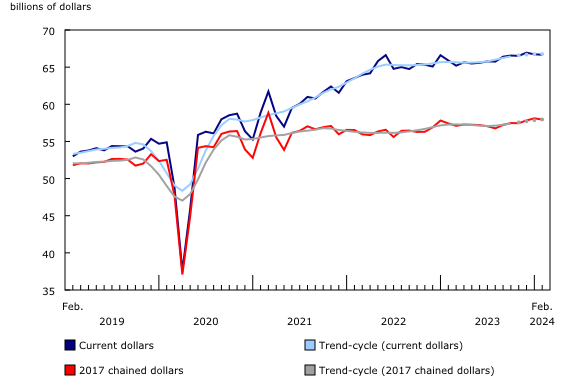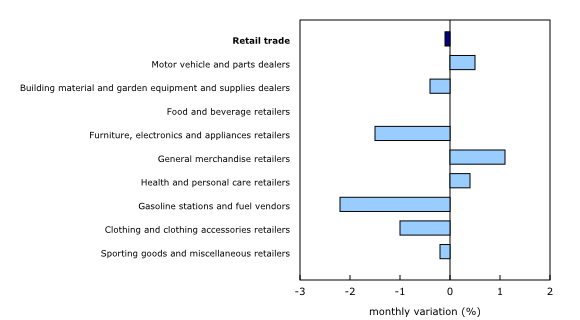Retail trade, February 2024
Released: 2024-04-24
$66.7 billion
February 2024
-0.1% 
(monthly change)
$1.0 billion
February 2024
3.5% 
(monthly change)
$0.3 billion
February 2024
-0.8% 
(monthly change)
$1.8 billion
February 2024
-1.5% 
(monthly change)
$1.5 billion
February 2024
-1.3% 
(monthly change)
$14.7 billion
February 2024
-0.1% 
(monthly change)
$25.3 billion
February 2024
-0.2% 
(monthly change)
$2.3 billion
February 2024
-0.7% 
(monthly change)
$2.1 billion
February 2024
1.7% 
(monthly change)
$8.4 billion
February 2024
-1.1% 
(monthly change)
$9.0 billion
February 2024
1.2% 
(monthly change)
$0.1 billion
February 2024
1.7% 
(monthly change)
$0.1 billion
February 2024
1.1% 
(monthly change)
$0.1 billion
February 2024
-1.5% 
(monthly change)
Retail sales decreased 0.1% to $66.7 billion in February. Sales were down in five of nine subsectors and were led by decreases at gasoline stations and fuel vendors (-2.2%).
Core retail sales—which exclude gasoline stations and fuel vendors and motor vehicle and parts dealers—were unchanged in February.
In volume terms, retail sales decreased 0.3% in February.
Sales at gasoline stations and fuel vendors fall, while sales at motor vehicle and parts dealers rise
Lower sales at gasoline stations and fuel vendors (-2.2%) led the decrease in retail sales in February. In volume terms, sales at gasoline stations and fuel vendors decreased 3.9%.
After their decline in January, sales at motor vehicle and parts dealers (+0.5%) were up in February. Other motor vehicle dealers (+5.1%) led the increase, followed by new car dealers (+0.3%). Gains at used car dealers (+0.3%) were more than offset by lower sales at automotive parts, accessories and tire retailers (-1.7%).
Core retail sales unchanged from January
Core retail sales were unchanged in February. Higher receipts were reported at general merchandise retailers (+1.1%) and, to a lesser extent, health and personal care retailers (+0.4%).
Offsetting these gains in February were lower sales at furniture, home furnishings, electronics and appliances retailers (-1.5%), clothing, clothing accessories, shoes, jewelry, luggage and leather goods retailers (-1.0%) and building material and garden equipment and supplies dealers (-0.4%).
Sales down in seven provinces
Retail sales decreased in seven provinces in February. The largest provincial decrease was observed in Alberta (-1.1%), led by lower sales at motor vehicle and parts dealers.
In Ontario, retail sales decreased 0.2% in February, led by lower sales at gasoline stations and fuel vendors. In the census metropolitan area of Toronto, sales were down 2.3%.
The largest provincial increase in retail sales in February was observed in British Columbia (+1.2%). The increase was led by higher sales at motor vehicle and parts dealers.
Retail e-commerce sales in Canada
On a seasonally adjusted basis, retail e-commerce sales were up 1.9% to $3.8 billion in February, accounting for 5.7% of total retail trade, compared with 5.6% in January.
Advance retail indicator
Statistics Canada is providing an advance estimate of retail sales, which suggests that sales were unchanged in March. Owing to its early nature, this figure will be revised. This unofficial estimate was calculated based on responses received from 61.9% of companies surveyed. The average final response rate to the survey over the previous 12 months was 90.7%.
Did you know we have a mobile app?
Download our mobile app and get timely access to data at your fingertips! The StatsCAN app is available for free on the App Store and on Google Play.
Note to readers
With this release, unadjusted monthly data were revised back to January 2023, while seasonally adjusted data were revised back to January 2020. Factors influencing revisions include the late receipt of respondent information, the correction of information in the data provided, the replacement of estimated figures with actual values (once available), the reclassification of companies within, into, and out of the retail trade sector, and updates to seasonal factors.
All data in this release are seasonally adjusted and expressed in current dollars, unless otherwise noted.
Seasonally adjusted data are data that have been modified to eliminate the effect of seasonal and calendar influences to allow for more meaningful comparisons of economic conditions from period to period. For more information on seasonal adjustment, see Seasonally adjusted data – Frequently asked questions.
The percentage change for the advance estimate of retail sales is calculated using seasonally adjusted data and is expressed in current dollars.
This early indicator is a special unofficial estimate being provided to offer Canadians timely information on the retail sector. The data sources and methodology used are the same as those outlined on the Monthly Retail Trade Survey information page.
Trend-cycle estimates are included in selected charts as a complement to the seasonally adjusted series. These data represent a smoothed version of the seasonally adjusted time series and provide information on longer-term movements, including changes in direction underlying the series. For information on trend-cycle data, see Trend-cycle estimates – Frequently asked questions.
Both seasonally adjusted data and trend-cycle estimates are subject to revision as additional observations become available. These revisions could be extensive and could even lead to a reversal of movement, especially for the reference months near the end of the series or during periods of economic disruption.
Some common e-commerce transactions, such as travel and accommodation bookings, ticket purchases and financial transactions, are not included in Canadian retail sales figures.
Total retail sales expressed in volume terms are calculated by deflating current-dollar values using consumer price indexes.
Find more statistics on retail trade.
Next release
Data on retail trade for March will be released on May 24.
Contact information
For more information, or to enquire about the concepts, methods or data quality of this release, contact us (toll-free 1-800-263-1136; 514-283-8300; infostats@statcan.gc.ca) or Media Relations (statcan.mediahotline-ligneinfomedias.statcan@statcan.gc.ca).
- Date modified:


